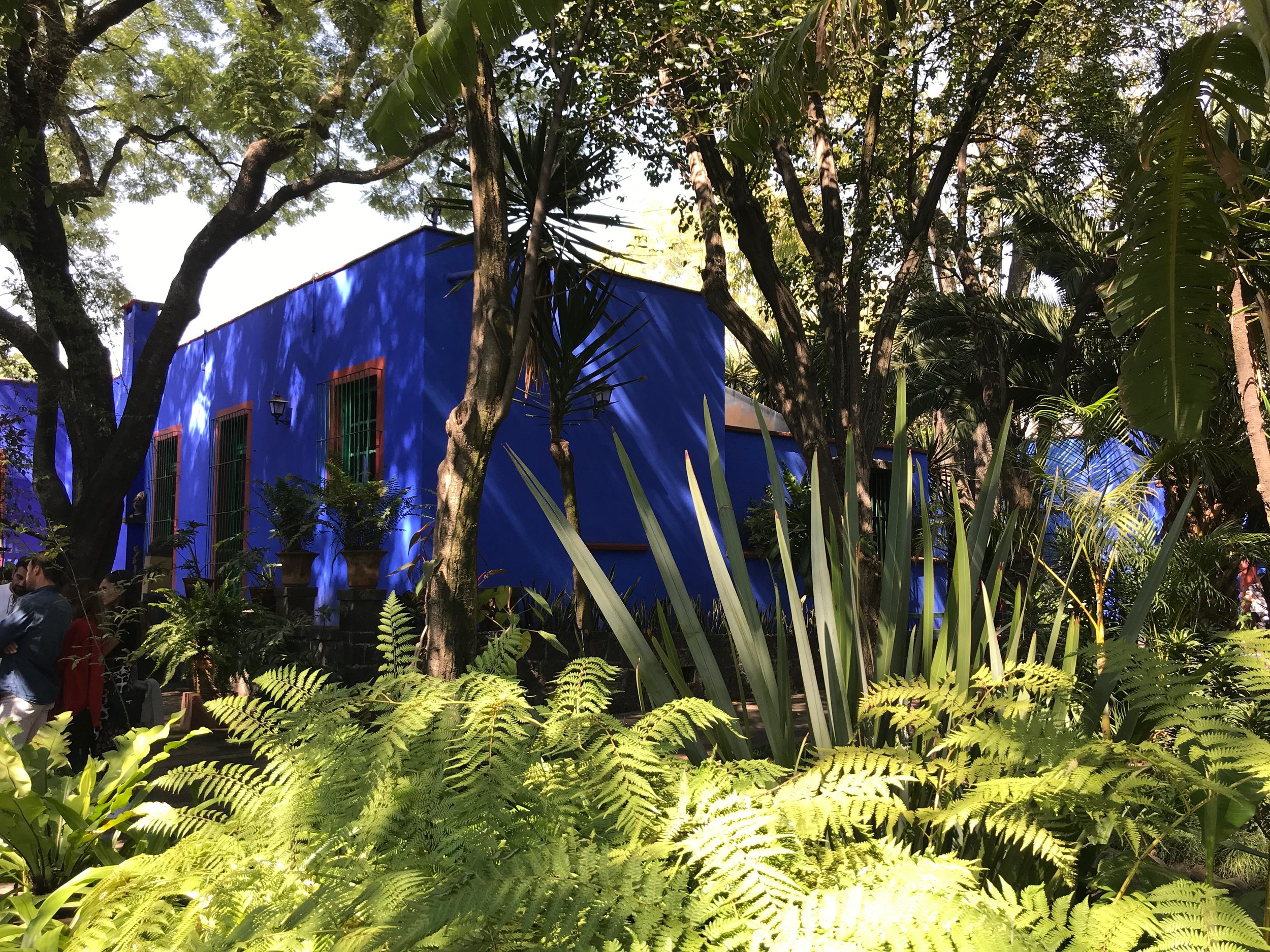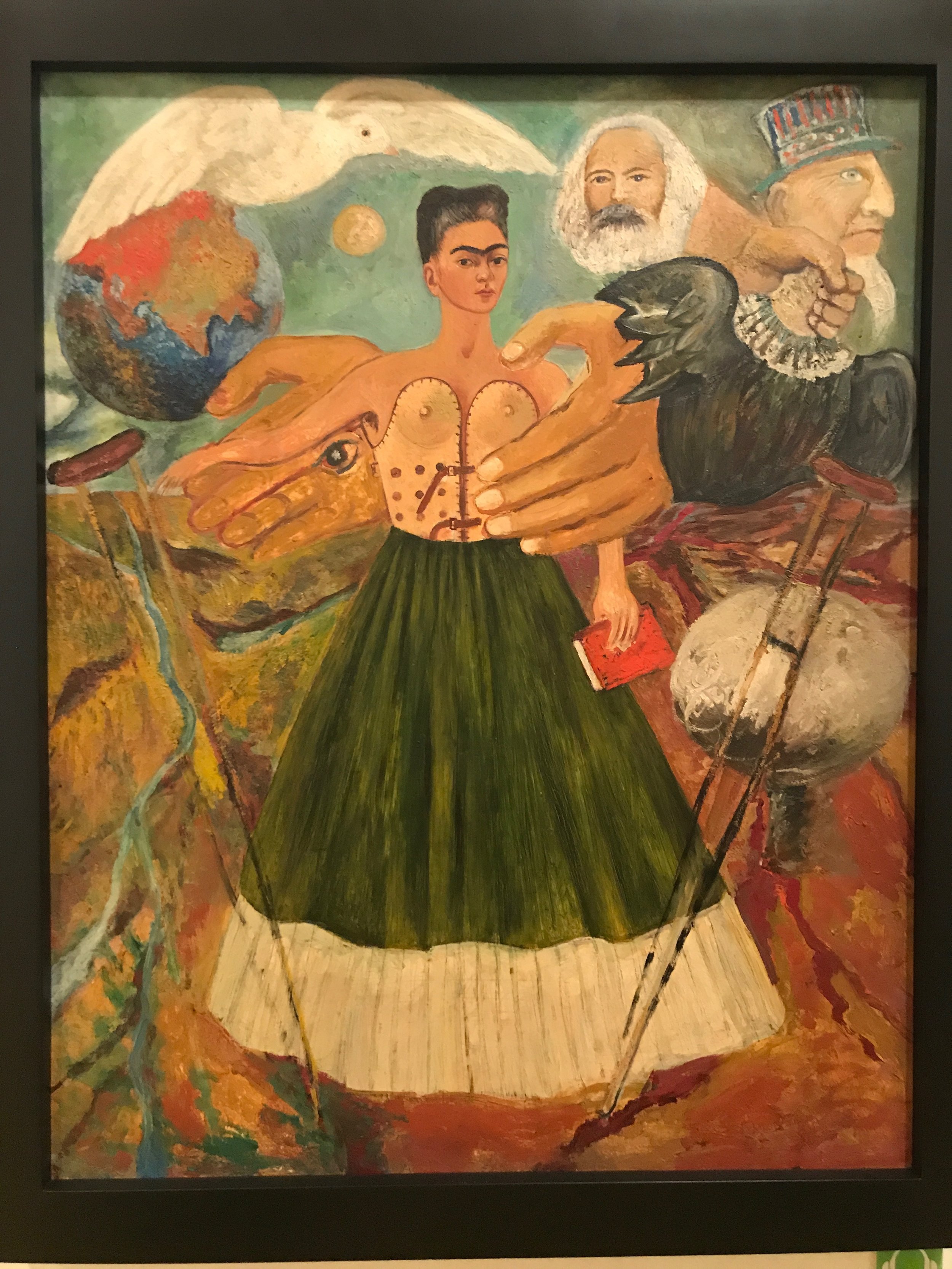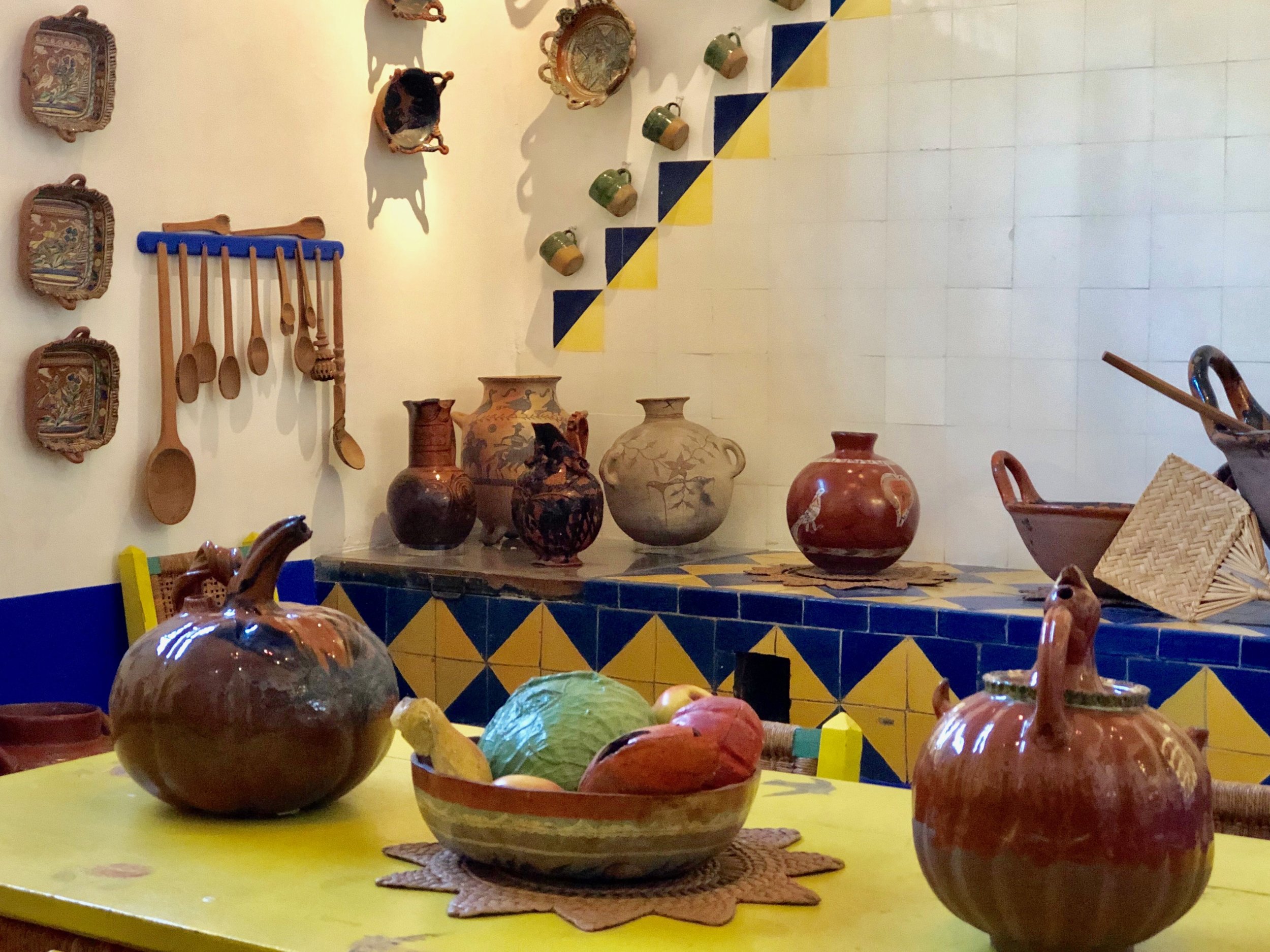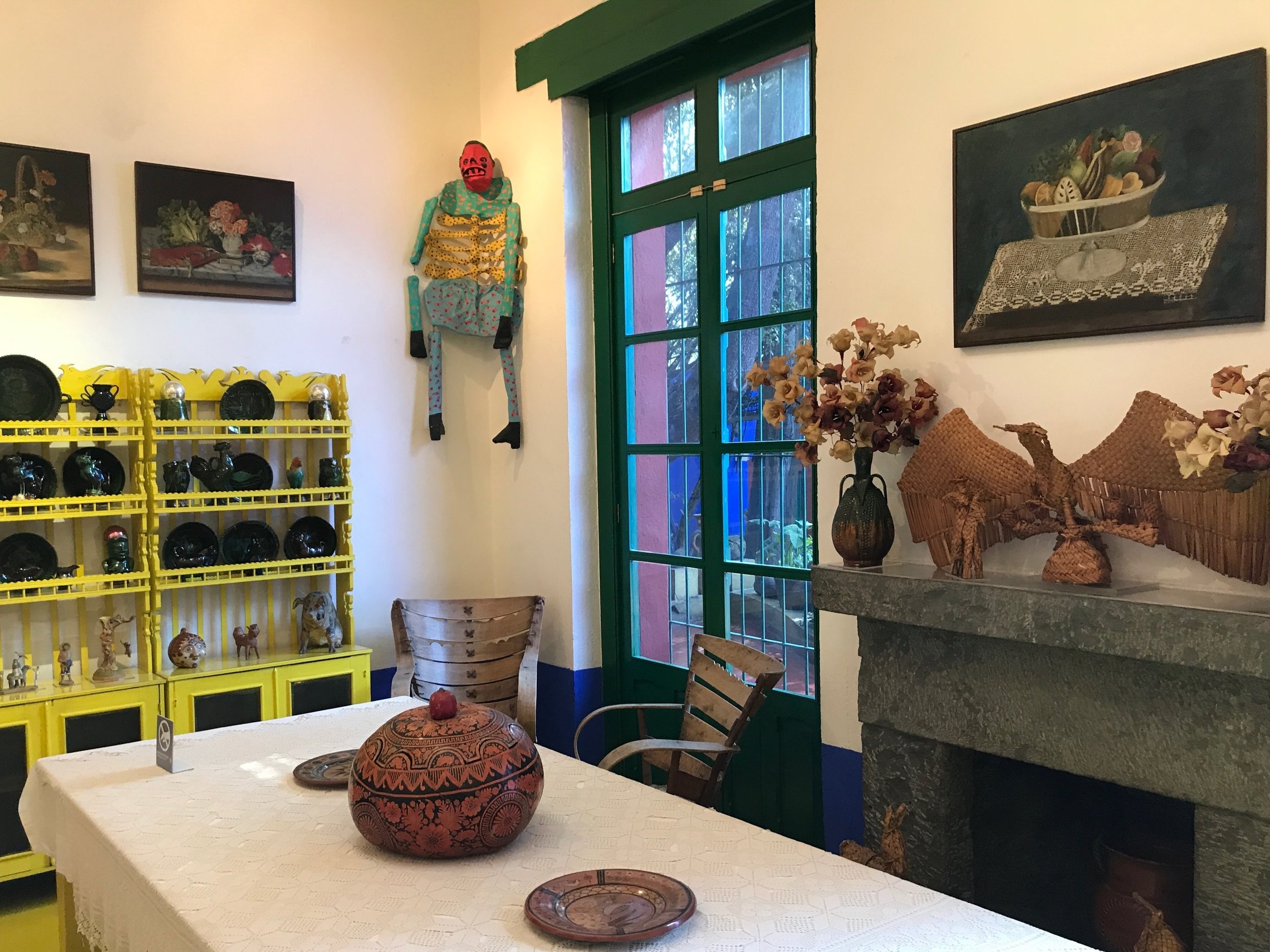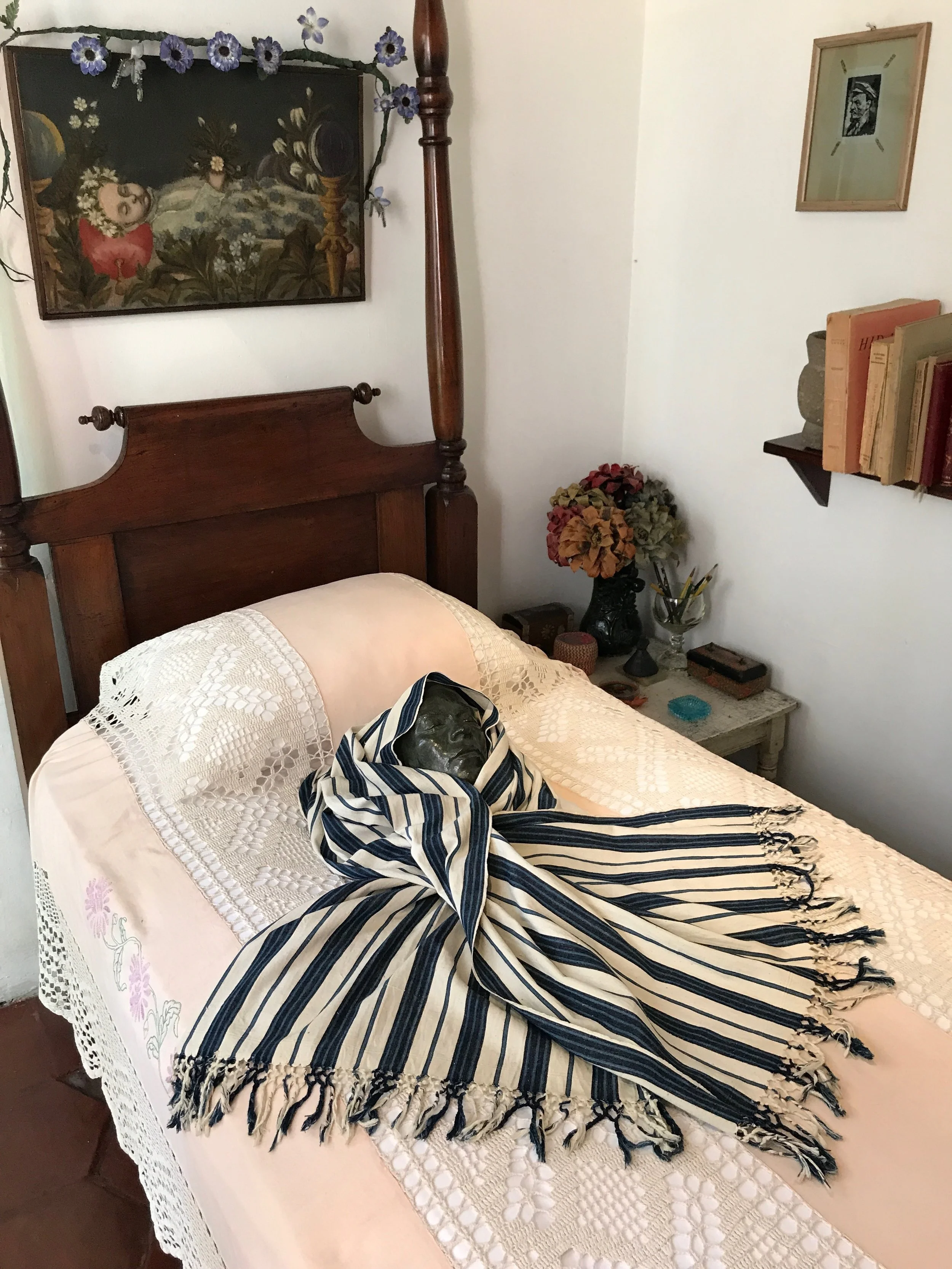Explore the quirky blue-painted home-turned-museum where the bohemian Mexican artist was born and lived while married to muralist Diego Rivera.
You can wander through the home Frida Kahlo and Diego Rivera lived in
One destination that was at the top of our list to visit while in CDMX was La Casa Azul, or the Blue House, the former home and studio of Mexican artist and revolutionary cultural icon Frida Kahlo.
The first thing to capture your attention upon arrival at the corner of Calles Londres and Allende, which is now the Museo Frida Kahlo, are the vibrant cobalt-blue walls that rise straight up from the sidewalk. They reminded me of the intense blue used by French painter Jacques Majorelle in his garden acquired by Yves St. Laurent and Pierre Bergé in Marrakech, Morocco.
“To be in the former home of this captivating, self-willed individual was an amazing and moving experience. ”
Get your tickets well before you visit — and get the earliest time available to cut down on crowds
The other was the line of people waiting to gain admission. After reading how popular the destination is, we purchased and printed our tickets in advance for the first available self-guided tour of the day to avoid the crowds. If you show up without a ticket, we’ve heard you can expect to wait up to four hours, as the museum limits the amount of people allowed inside. Even if you get your tickets in advance, plan on getting into line half an hour early so you’re at the beginning of your group.
Portrait of Frida Kahlo by Roberto Montenegro, 1936
You can download an electronic version of your ticket, which will be scanned by one of the museum docents. If you’d like to take pictures inside, which we did, you’ll need to purchase a photography pass for an extra fee of about 30 pesos, or $1.50.
Keep in mind that the cost of your ticket also includes admission to the Anahuacalli Museum, designed by Diego Rivera to contain his impressive collection of pre-Columbian art. It’s great fun to explore.
Duke leans on the iconic blue walls of La Casa Azul while we wait to go in
It’s cool being able to explore the home shared by these two famous artists
Inside La Casa Azul
At the entry, you’re met by a few of Kahlo’s fantastical and monstrous papier-mâché folk art alebrije figures, traditionally representing Satan and Judas, which are filled with firecrackers and exploded on Sabado de Gloria, the Saturday before Easter.
Part of the courtyard includes this tiled pool
Built around an open-air central courtyard, the interior of the house offers visitors a chance to catch a glimpse into Frida’s creative universe. Each room is organized by theme, many exactly as Kahlo left them. The first room Wally and I entered was originally the formal living room, where the Riveras hosted storied intellectual guests from Gershwin to Trotsky and now functions as a gallery featuring a selection of Frida’s lesser-known paintings. Of note is Portrait of My Father, made by Kahlo 10 years after her father’s death with the dedication “I painted my father Wilhelm Kahlo, of Hungarian-German origin, artist-photographer by profession, in character generous, intelligent and fine, valiant because he suffered for 60 years with epilepsy, but never gave up working and fought against Hitler. With adoration, his daughter, Frida Kahlo,” and a still life depicting sliced watermelons inscribed with the phrase “Viva la Vida” or, Long Live Life.
Marxism Will Give Health to the Sick by Frida Kahlo, 1954
Portrait of My Father by Frida Kahlo, 1951
Viva la Vida by Frida Kahlo, 1954 — the last of her paintings she signed
The next room held a delightful miniature puppet theater created by Frida. One of my favorite items in the house, it contained a cat or perhaps jaguar, a seated woman, a skeleton with a red sash around its waist and an alligator suspended in the air. Also on display was a painting by Diego Rivera titled La Quebrada. The inscription in the lower right corner reads, “A La Niña Fridita Kahlo la maravillosa. El 7 de Julio de 1956 a los dos años que duerme en cenizas, viva en mi corazón” (To the little girl Fridita Kahlo, the wonderful one. On July 7, 1956, two years since she went to sleep in the ashes, she lives on in my heart.)
We especially loved this kinda creepy puppet theater Frida created
Moving farther along, white painted ceiling beams and bold blue, yellow and white glazed tiles complement the kitchen countertop and frame the chimney. Kahlo embellished the walls surrounding the wood-burning stove using miniature glazed clay mugs to whimsically spell out her and Diego’s names. On the opposite wall are two doves tying a lovers’ knot and a pair of pumpkin-shaped clay tureens sitting atop a long yellow table.
Frida spelled out her and Diego’s names in miniature clay mugs on the wall above her stove
A glimpse into Frida’s kitchen
The neutral tones of earthenware pottery pair nicely with the bright blue and yellow tiles
Next to the kitchen, the dining room shares the same vibrant color scheme with bright yellow open storage shelving chock full of colored glassware, earthenware pots, plates and indigenous artifacts.
The dining room
A bright yellow cabinet displaying some of Frida’s collections
Rivera’s small bedroom is tucked off to the side of the dining room. A pillow sitting on a vintage armchair is embroidered with the words “Despierta Corazon Dormido” (Wake Up, Sleeping Heart). Outside this room, a flight of stairs leads to the second floor library and studio, an addition by Rivera.
The small room Diego stayed in also once housed Leon Trotsky, with whom Frida had an affair
Up in the studio, large steel-framed windows look out to the garden and fill the room with natural light. There’s also an enviable collection of books. Kahlo’s small wooden work desk holds an assortment of brushes, a palette, a mirror and small glass bottles of pigment waiting to be mixed for use.
Frida’s work table: where the magic happened
The materials Frida used in her paintings
Color pigments Frida used to create her paint
Adjacent to these tools, a wheelchair faces an easel with the painting Still Life With Flag — a reminder that Frida experienced a series of life events that left her in chronic pain. At the age of 6, she contracted polio, which left her right leg withered and shorter than her left, causing her to limp. In her teens, while traveling home from school, the bus on which she was riding was hit by a streetcar. She sustained serious trauma, including multiple fractures of the clavicle, ribs and spine, and was pierced by an iron handrail from the streetcar that impaled her pelvis. Frida miraculously survived and and began painting self-portraits — her reality captured by a mirror within the intimacy of her own studio at home. She once said, “I paint myself because I am so often alone and because I am the subject I know best.”
In poor health for much of her life, Frida had to paint in a wheelchair now and then
Immediately off the artists studio are a pair of Kahlo’s four-poster beds. As Frida was frequently bedridden, her day bed is fitted with a mirror above that she would use to paint while convalescing. Because she died in this room in 1954, her death mask fittingly (yet creepily) rests atop the bed. On the wall behind the headboard, a skeleton with tiny arms wearing a top hat and a painting of a presumably dead child with a garland of purple poppy flowers watch over the bed.
Frida’s death mask sits on her bed
Frida’s night bed has a framed grouping of butterfly specimens attached to the panel above. These were given to her by Japanese-American sculptor Isamu Noguchi. On a lace-topped table nearby a headless pre-Columbian urn contains her ashes. A cabinet of toys rendered in miniature are displayed off to the right.
The large urn to the left contains Frida’s ashes
We exited via a staircase from Frida’s day room in the central courtyard and followed a winding path that led us past a stepped pyramidal structure, added and built by Rivera, a pedestal to display their pre-Columbian sculptures in the garden. Frida loved botany and collected many species of plants native to Mexico and created a garden abundant with yuccas, bougainvilleas, cacti, jasmine and agave.
Wally and Duke on the patio leading to the central courtyard
Diego especially loved pre-Columbian artifacts
A large ofrenda is set up in the garden
Around back you’ll find an opportunity to pretend to be Frida and Diego
An ancillary building contains an exhibit named after a drawing Kahlo made in 1946: Appearances Can Be Deceiving, where the artist drew herself, showing an X-ray view through her traditional Tehuana dress to reveal her injured leg and plaster corset. The first room displays a few of Kahlo’s personal objects used in relation to her medical condition. There’s also a vitrine with mannequins wearing Kahlo’s distinctive Tehuana dresses and headpieces. She favored the huipil, a boxy blouse, rebozo shawl and long skirt, a representation of Kahlo’s authentic Mexican femininity. There’s also a couture dress with a buckled corset by fashion designer and provocateur Jean Paul Gaultier whose 1998 spring-summer runway was titled Tribute to Frida Kahlo. In this same case is a dress by Rei Kawakubo for Comme des Garçons surrounded by a sort of hoop cage, and in the last room there’s a delicately embroidered bodysuit with an incredible fringe jacket by Roberto Tisci for Givenchy.
An outbuilding houses some of Frida’s distinctive outfits
A dress by Comme des Garçons (left) and The Freckles by Gaultier
To be in the former home of this captivating, self-willed individual was an amazing and moving experience. Like Kahlo, La Casa Azul has many layers — its details bear witness to her inspired magpie approach, filled with objects that carried personal meaning to Kahlo and are reflected in her fascinating collection of arte popular. –Duke
La Casa Azul, the Museo Frida Kahlo
Frida Kahlo Museum
Londres 247
Del Carmen
04100 Ciudad de México, CDMX
Mexico

